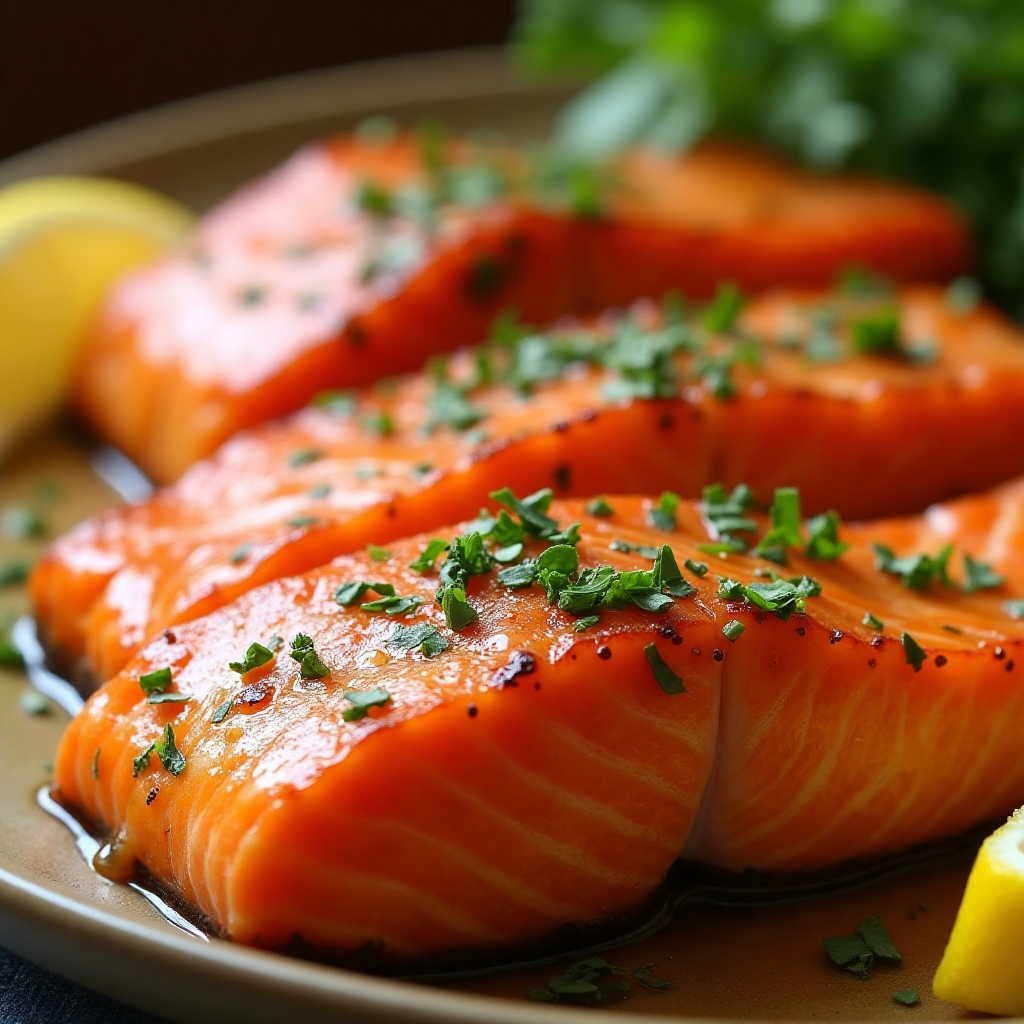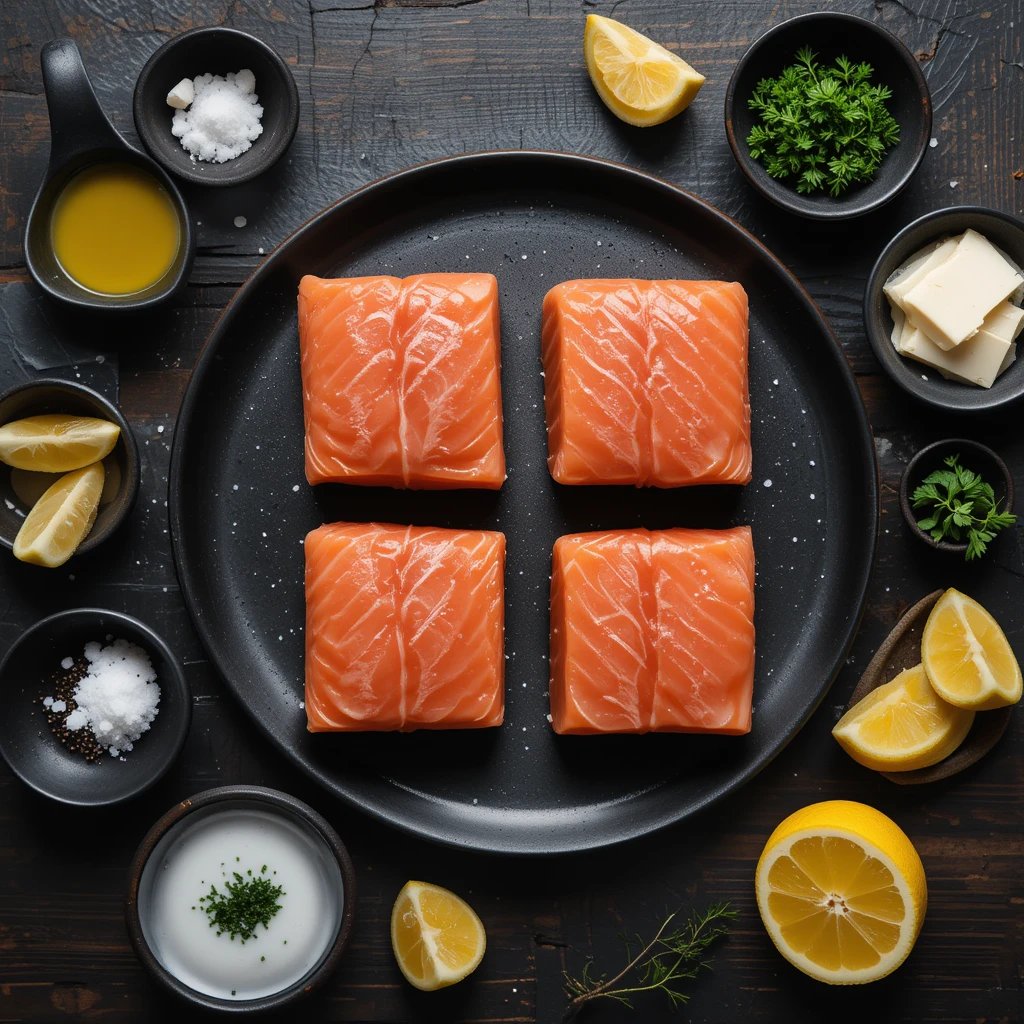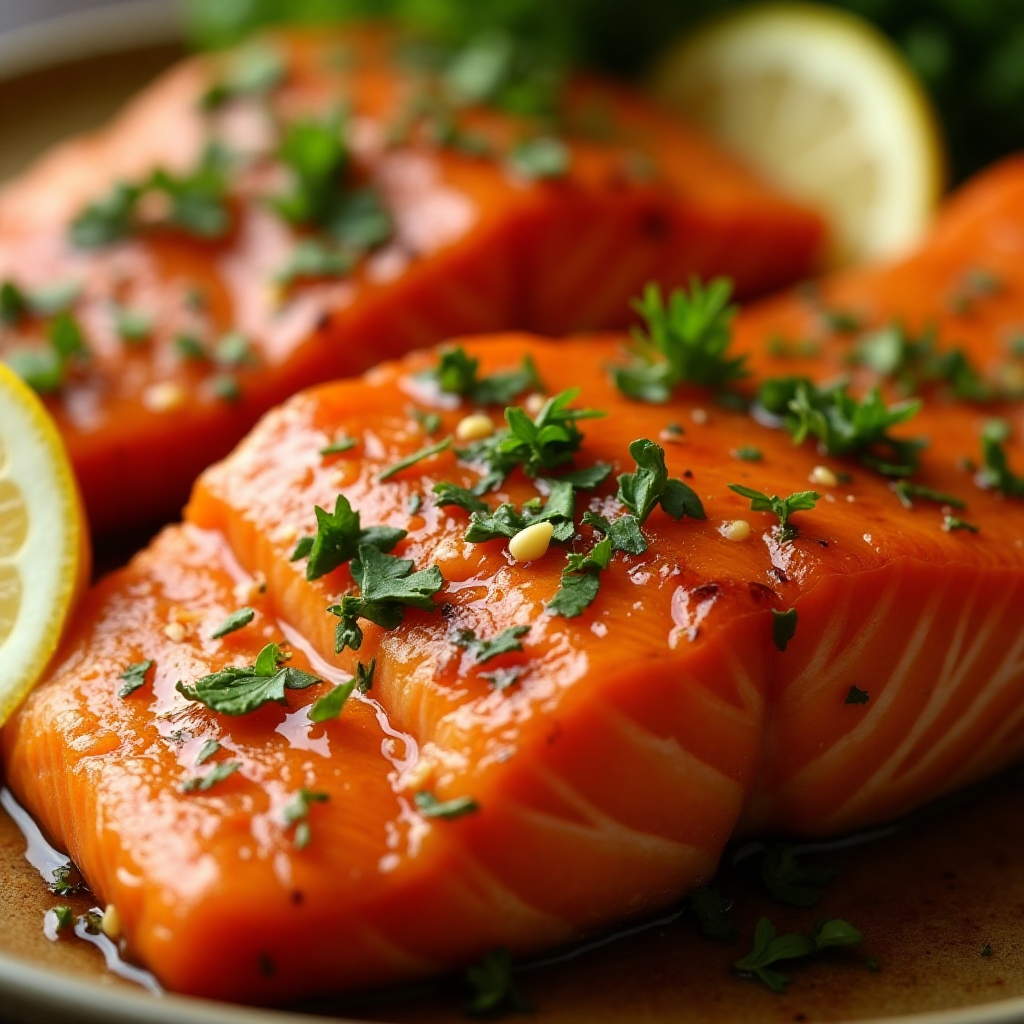How To Cook Sockeye Salmon in a Pan
Picture this: golden, crispy-skinned salmon with tender, flaky flesh that practically melts in your mouth. That’s exactly what you’ll get when you master how to cook sockeye salmon in a pan! This gorgeous Pacific salmon variety boasts a rich, buttery flavor that’s absolutely divine when cooked properly.
Here’s a fun fact – sockeye salmon gets its vibrant red color from eating krill and shrimp, making it one of the most nutritious fish you can put on your dinner table. What makes this dish truly special is its incredible simplicity. In just 15 minutes, you can create a restaurant-quality meal that rivals any fancy steakhouse.
Table of Contents
Unlike our popular honey garlic chicken thighs that require marinating time, this pan-seared sockeye salmon comes together lightning-fast, making it perfect for busy weeknights when you want something elegant without the fuss. Get ready to impress your family and friends with this foolproof technique that guarantees perfect results every single time!
What is Pan-Seared Sockeye Salmon?
Ever wondered why this cooking method has captured the hearts of home cooks everywhere? Pan-seared sockeye salmon is simply fresh sockeye salmon fillets cooked in a hot skillet until they develop that coveted golden-brown crust while keeping the interior perfectly moist and flaky.
But here’s the thing – why do we call it “pan-seared” when we’re essentially just cooking fish in a pan? The magic happens when high heat meets proper technique, creating what chefs call the Maillard reaction – that beautiful browning that locks in flavor and creates an irresistible texture contrast.
My grandmother always said, “the way to a man’s heart is through his stomach,” and let me tell you, this dish has won over more dinner guests than I can count! The combination of sockeye salmon’s naturally rich flavor with a perfectly crispy exterior creates a dining experience that feels both luxurious and comforting. Ready to become the salmon-cooking champion of your household?

Why You’ll Love This Pan-Seared Sockeye Salmon
The Ultimate Flavor Experience The star of this dish is undoubtedly the sockeye salmon itself. Unlike other salmon varieties, sockeye has a deep, complex flavor that’s both rich and clean. When you learn how to cook sockeye salmon in a pan properly, you’ll unlock layers of buttery goodness that pair beautifully with the caramelized, crispy skin. The contrast between the golden exterior and the tender, coral-colored flesh creates a sensory experience that’s simply unforgettable.
Budget-Friendly Gourmet Dining Restaurant-quality salmon dinners can easily cost $25-30 per person, but making this dish at home costs a fraction of that price. You’re getting the same high-end experience without the hefty price tag. Plus, you control the quality of ingredients and cooking method, often resulting in a better meal than what you’d get dining out.
Versatile and Customizable What makes this recipe truly special is its adaptability. Whether you prefer a simple salt and pepper seasoning or want to get creative with herb crusts and compound butters, the basic technique remains the same. You can pair it with everything from roasted vegetables to creamy risotto, making it as casual or elegant as your occasion demands.
Similar to our popular pan-seared chicken breast recipe, this salmon technique is all about mastering the fundamentals, then making it your own. Once you’ve got the basics down, you’ll find yourself reaching for this recipe again and again. Why not give it a try tonight and see what all the fuss is about?
How to Make Pan-Seared Sockeye Salmon
Quick Overview
This pan-seared sockeye salmon recipe delivers restaurant-quality results in just 15 minutes from start to finish. The key to success lies in getting that perfect golden crust while keeping the interior moist and flaky. With its rich, buttery flavor and elegant presentation, this dish transforms any ordinary weeknight into a special occasion.
The preparation is surprisingly simple, requiring just a few high-quality ingredients and proper technique to create a meal that looks and tastes like it came from a five-star restaurant.
Key Ingredients for Pan-Seared Sockeye Salmon
For the Salmon:
- 4 sockeye salmon fillets (6 oz each), skin-on, pin bones removed
- 2 tablespoons olive oil or avocado oil
- 1 teaspoon kosher salt
- 1/2 teaspoon freshly ground black pepper
- 1 tablespoon butter
For the Simple Herb Finishing:
- 2 tablespoons fresh lemon juice
- 1 tablespoon fresh dill, chopped
- 1 tablespoon fresh parsley, chopped
- 1 clove garlic, minced
- Lemon wedges for serving
Pro tip: Look for bright, firm fillets with no fishy smell. The skin should be shiny and scales intact if present.

Step-by-Step Instructions
Step 1: Prepare the Salmon Remove the salmon from the refrigerator 15-20 minutes before cooking to bring it to room temperature. Pat the fillets completely dry with paper towels – this is crucial for achieving that perfect crispy skin. Season both sides generously with kosher salt and freshly ground black pepper.
Step 2: Heat Your Pan Place a large stainless steel or cast iron skillet over medium-high heat. Add the olive oil and let it heat until it shimmers but doesn’t smoke. The oil should move freely around the pan when you tilt it.
Step 3: Sear the Salmon Gently place the salmon fillets skin-side down in the hot pan. You should hear an immediate sizzle – this is good! Don’t move the fish for 4-5 minutes. The skin will release naturally when it’s ready to flip.
Step 4: Check for Doneness The salmon is ready to flip when you can easily slide a spatula under the skin without resistance. The flesh should be opaque about 3/4 of the way up the sides of the fillet.
Step 5: Flip and Finish Carefully flip the salmon and cook for another 2-3 minutes for medium doneness. Add the butter to the pan and baste the salmon with the melted butter using a spoon.
Step 6: Rest and Serve Remove the salmon from heat and let it rest for 2 minutes. Drizzle with fresh lemon juice and sprinkle with herbs. Serve immediately with lemon wedges.

What to Serve Pan-Seared Sockeye Salmon With
Classic Pairings:
- Roasted asparagus with lemon and garlic
- Creamy mashed potatoes or herb-roasted fingerlings
- Wild rice pilaf with cranberries and almonds
- Steamed broccoli with butter and lemon
Wine Pairings:
- Crisp white wines like Sauvignon Blanc or Pinot Grigio
- Light red wines such as Pinot Noir
- Rosé for a refreshing summer option
Complete Meal Ideas: Create a balanced plate by combining the salmon with a starch, vegetable, and fresh element. Try serving it over a bed of arugula with roasted sweet potatoes and a dollop of tzatziki, or alongside quinoa pilaf and roasted Brussels sprouts for a nutritious, satisfying meal.
Top Tips for Perfecting Pan-Seared Sockeye Salmon
Temperature Control is Key The most common mistake when learning how to cook sockeye salmon in a pan is using too high heat. Medium-high heat allows the skin to crisp without burning while cooking the flesh evenly. If your pan is smoking, it’s too hot.
Don’t Rush the Flip Patience is essential for perfect salmon. The fish will naturally release from the pan when the skin is properly crisped. Trying to flip too early will result in torn skin and uneven cooking.
Invest in Quality Fish Since salmon is the star of this dish, quality matters. Look for wild-caught sockeye salmon from reputable fishmongers. The flesh should be firm, bright red, and smell like the ocean, not “fishy.”
Skin-Side Down First Always start with the skin side down. This protects the delicate flesh from direct heat and creates that coveted crispy skin. The skin acts as a natural barrier, preventing overcooking.
Use a Fish Spatula A thin, flexible fish spatula makes flipping salmon foolproof. Its beveled edge slides easily under the fish without breaking the fillet.
Check Internal Temperature For food safety and perfect doneness, use an instant-read thermometer. Salmon is done at 145°F internal temperature, though many prefer it slightly less done at 125-130°F for a more tender texture.
Storing and Reheating Tips
Refrigerator Storage: Store leftover cooked salmon in an airtight container in the refrigerator for up to 3 days. Place parchment paper between fillets to prevent sticking.
Freezer Storage: While fresh salmon freezes well before cooking, cooked salmon can be frozen for up to 2 months. Wrap tightly in plastic wrap, then aluminum foil to prevent freezer burn.
Reheating Methods:
- Oven method: Preheat to 275°F, wrap salmon in foil with a splash of white wine or broth, and heat for 15 minutes.
- Stovetop method: Heat in a covered pan over low heat with a little butter or oil for 3-4 minutes.
- Microwave method: Use 50% power in 30-second intervals, covering with a damp paper towel.
Cold Serving Options: Leftover salmon is excellent served cold in salads, on bagels with cream cheese, or flaked into pasta salads. The rich flavor actually develops more complexity when chilled.
Frequently Asked Questions
How do I know when the salmon is done cooking?
The salmon is perfectly cooked when it flakes easily with a fork and the internal temperature reaches 145°F. The flesh should be opaque and separate into distinct flakes. For a more tender texture, many chefs prefer 125-130°F.
Can I cook salmon without the skin?
Yes, you can cook skinless salmon fillets using the same method. Start with the presentation side down first, then flip once. Cooking time may be slightly reduced since there’s no skin to protect the flesh.
What’s the best oil for cooking salmon?
High-heat oils like avocado oil, grapeseed oil, or refined olive oil work best. These oils have higher smoke points and won’t break down at the temperatures needed for proper searing.
How can I prevent the salmon from sticking?
Ensure your pan is properly heated, use enough oil, and most importantly, don’t move the fish until it’s ready to flip. A properly heated pan with adequate oil should prevent sticking.
Can I use frozen salmon for this recipe?
Yes, but thaw the salmon completely first. Pat it extra dry and let it come to room temperature before cooking. Frozen salmon may release more moisture during cooking, so adjust accordingly.
Nutritional Information
| Nutrient | Per Serving (6 oz fillet) |
|---|---|
| Calories | 350 |
| Protein | 39g |
| Fat | 20g |
| Saturated Fat | 4g |
| Omega-3 Fatty Acids | 1.8g |
| Cholesterol | 94mg |
| Sodium | 590mg |
| Carbohydrates | 0g |
| Fiber | 0g |
Nutritional values are approximate and may vary based on specific ingredients and preparation methods.
Ready to master the art of cooking sockeye salmon? This foolproof method for how to cook sockeye salmon in a pan will transform your weeknight dinners into restaurant-quality experiences. The combination of crispy skin and tender, flaky flesh creates a dish that’s both elegant and satisfying. Whether you’re cooking for a special occasion or simply want to treat yourself to something delicious, this recipe delivers every time. Give it a try tonight and discover why pan-seared sockeye salmon has become a favorite among home cooks everywhere!
